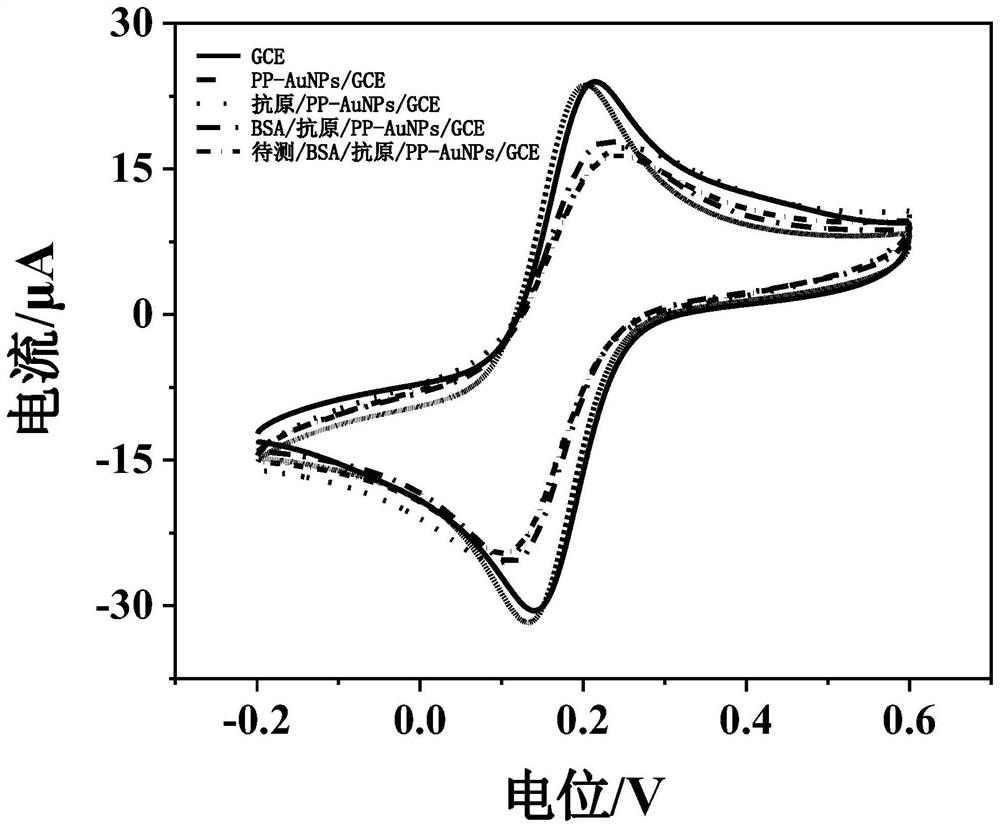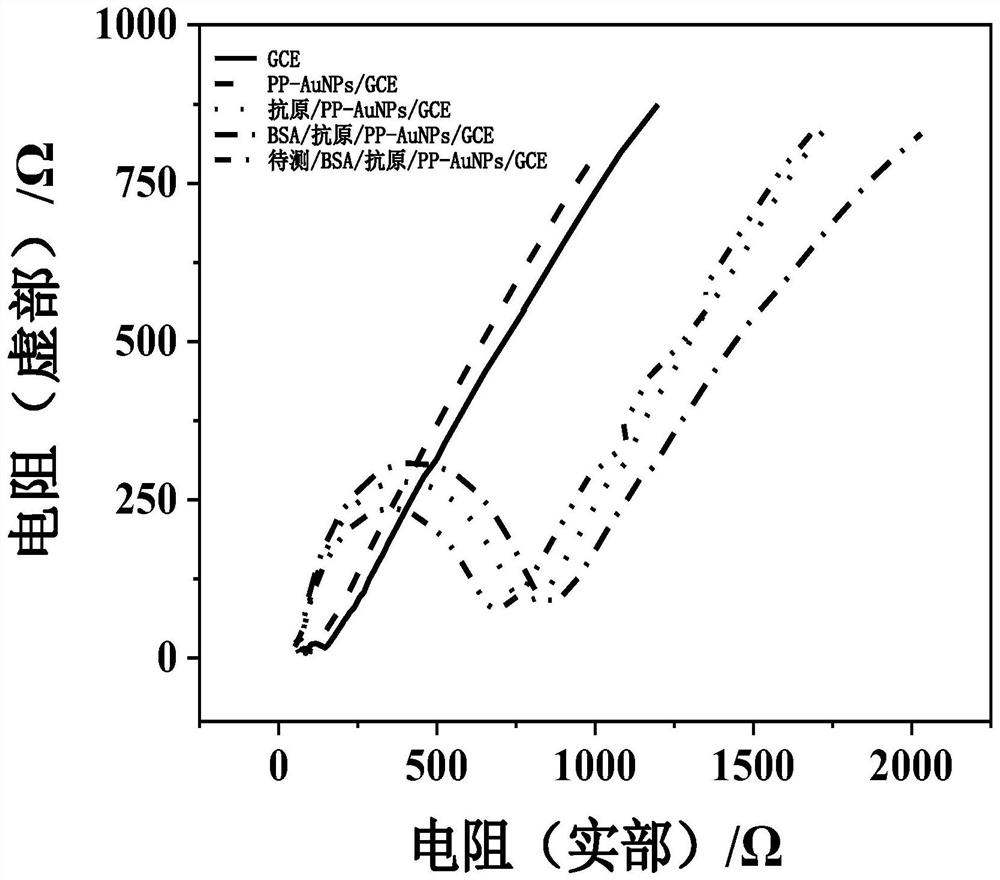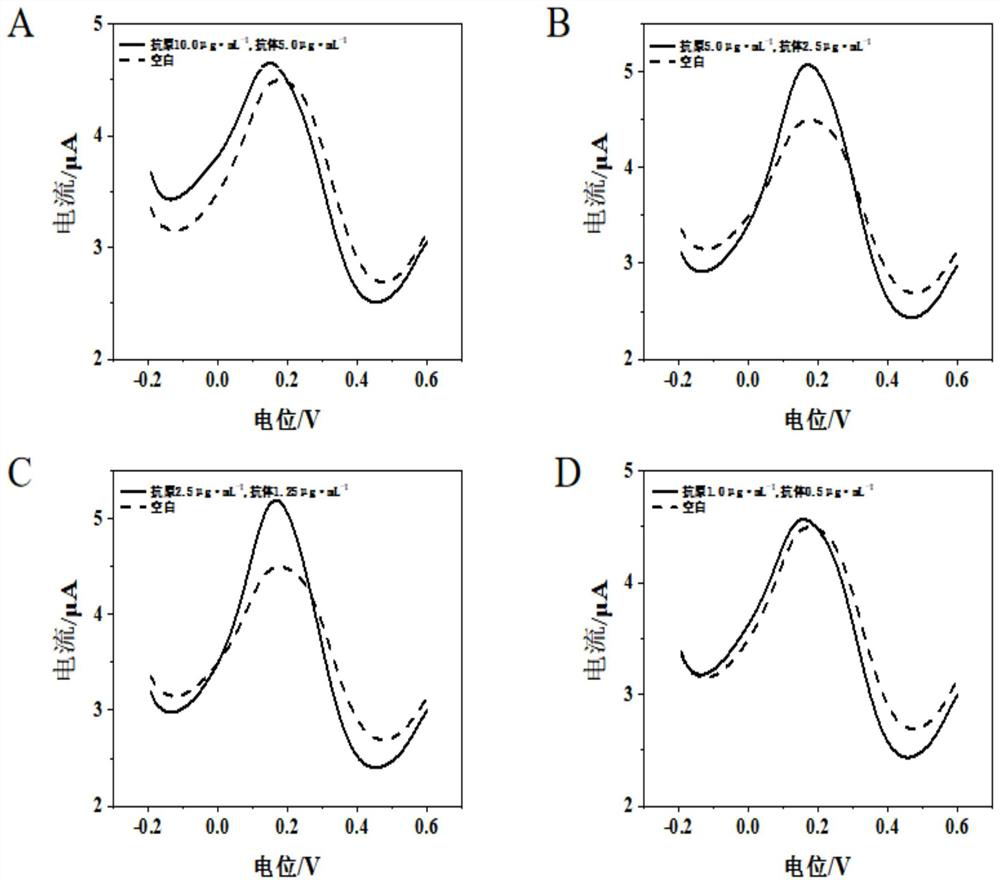Polypeptide-nanogold modified glassy carbon electrode and application thereof
A technology of glassy carbon electrode and nano-gold, which is applied in the field of polypeptide-nano-gold modified glassy carbon electrode, to achieve the effects of improving electrochemical response signal, high synergy, good stability and reproducibility
- Summary
- Abstract
- Description
- Claims
- Application Information
AI Technical Summary
Problems solved by technology
Method used
Image
Examples
Embodiment 1
[0038] Embodiment 1 prepares the glassy carbon electrode modified by polypeptide-nanogold, comprising the following steps:
[0039] Step 1. Soak all the glass instruments required for the synthesis of composite materials in an acid tank for one day, take them out and thoroughly rinse them with ultrapure water, and dry them in a constant temperature box at 37°C for later use.
[0040] Step 2, HAuCl 4 The solid was dissolved in ultrapure water to prepare a concentration of 10 mg·mL -1 mother solution, and then the freeze-dried polypeptide was dissolved in 20mL HEPES solution to prepare 0.04mmol·L -1 peptide solution.
[0041] Step 3, take 80 μL HAuCl 4 Add the mother liquor to 20mL of polypeptide HEPES solution, and stir at room temperature for 1-2h to obtain the PP-AuNPs composite material.
[0042] Step 4, the bare glassy carbon electrode was ground and polished on alumina powder, then ultrasonically treated in absolute ethanol and water, rinsed with water and placed in po...
Embodiment 2
[0043] The characterization of embodiment 2 modified electrode performance:
[0044] In order to verify whether the electrochemical immunosensor was successfully constructed, cyclic voltammetry was used to study and compare GCE, PP-AuNPs / GCE, antigen / PP-AuNPs / GCE, BSA / antigen / PP-AuNPs / GCE and test / BSA / antigen / The five electrodes of PP-AuNPs / GCE were in potassium ferricyanide solution (1mmol L -1 ) in the electrochemical response signal. Such as figure 1 As shown, these five modified electrodes all have a pair of good redox peaks in potassium ferricyanide solution. On GCE, the potential difference between the redox peaks is less than 75mV, indicating that the electrode activation is better and the conductivity is better. The curve of the electrode modified by PP-AuNPs is more beautiful, and the oxidation peak is slightly reduced, the reduction peak is more obvious, and the peak potential difference is reduced, which shows that PP-AuNPs has been successfully modified on GCE,...
Embodiment 3
[0046] The optimization of embodiment 3 experimental parameters affects the detection of aflatoxin:
[0047] Optimization of antigen concentration ( image 3): Detection of electrochemical signals by differential pulse voltammetry (potential range: -0.2-0.6V, amplitude: 0.05V). Under the conditions of room temperature (25°C), pH=7.4, and incubation time of 20 minutes, set the concentration ratio of antigen and antibody to 2:1, and the detection concentration is 5.0ng·mL -1 The mixed test solution of aflatoxin and antibody, the electrochemical response intensity of aflatoxin is affected by the concentration of antigen and antibody, resulting in different response signals. At the same time, it is compared with the blank liquid to be tested, and the current to be tested - blank current = ΔI is defined, and the detection effect is judged by the size of ΔI. When the concentration of Aspergillus flavus antigen was 10.0 μg·mL -1 and 1.0 μg·mL -1 When , the reduction peak current ...
PUM
 Login to View More
Login to View More Abstract
Description
Claims
Application Information
 Login to View More
Login to View More - R&D
- Intellectual Property
- Life Sciences
- Materials
- Tech Scout
- Unparalleled Data Quality
- Higher Quality Content
- 60% Fewer Hallucinations
Browse by: Latest US Patents, China's latest patents, Technical Efficacy Thesaurus, Application Domain, Technology Topic, Popular Technical Reports.
© 2025 PatSnap. All rights reserved.Legal|Privacy policy|Modern Slavery Act Transparency Statement|Sitemap|About US| Contact US: help@patsnap.com



